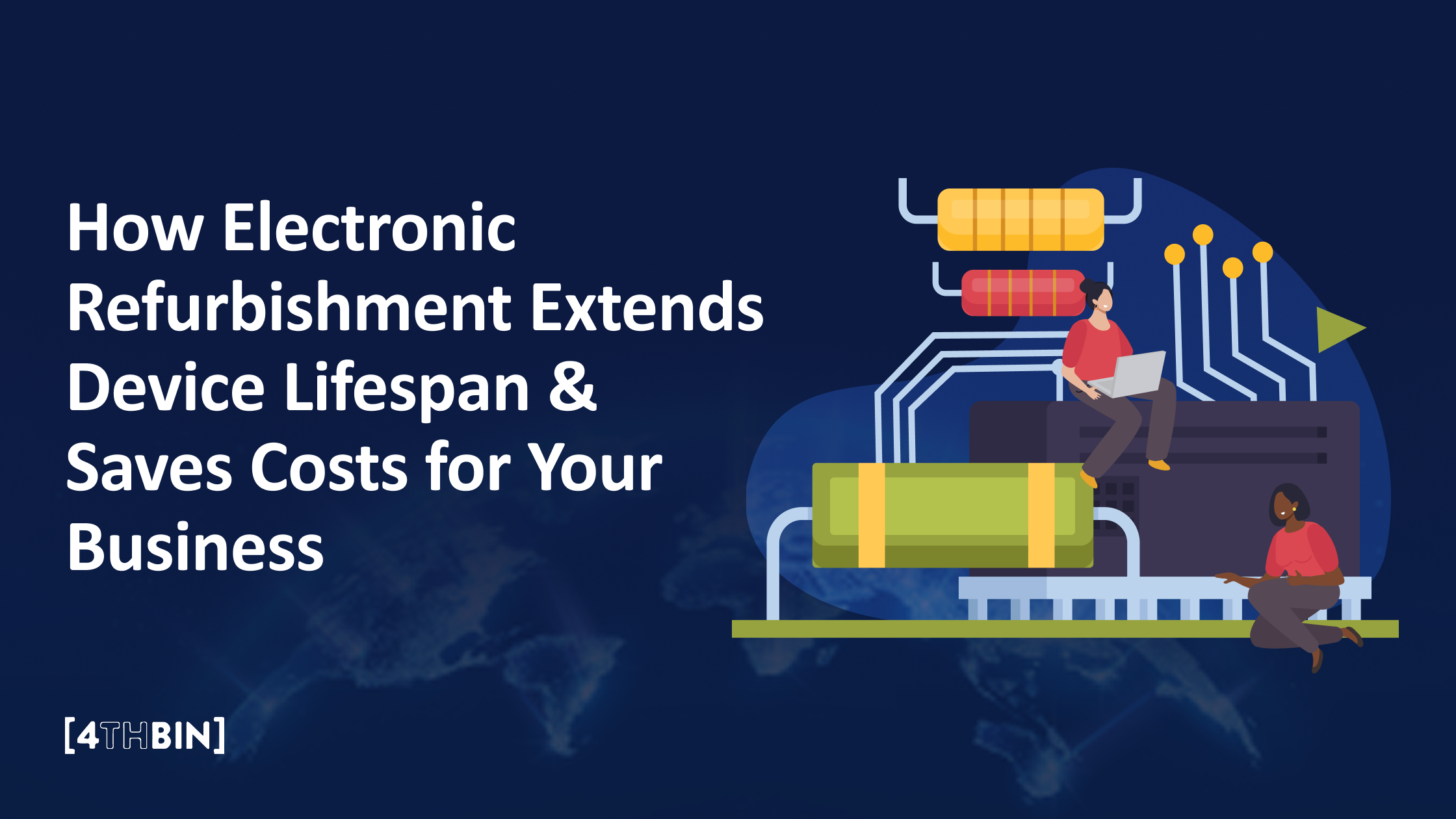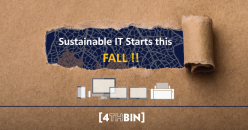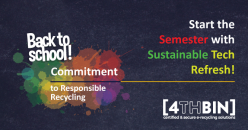12 Eye-Opening Recycling Facts and Statistics for 2025
Waste is piling up at an unprecedented rate, and how we manage it has far-reaching consequences for businesses, individuals, and the planet.
Every discarded device, plastic bottle, or food wrapper represents more than just trash. It’s a missed opportunity to recover valuable materials, reduce environmental harm, and drive economic growth.
For businesses, recycling isn’t just about sustainability. It’s about cutting costs, improving supply chains, and tapping into a lucrative market. For individuals, understanding how waste is handled means making informed choices that reduce pollution and support a healthier future.
But how much do we really know about the state of recycling today? The facts might surprise you. From the alarming rise of e-waste to the hidden financial impact of poor waste management, these eye-opening statistics reveal why recycling matters more than ever in 2025.
Top Recycling Facts and Statistics for 2025
Here are top facts and statistics that highlight where we stand, what’s at stake, and why recycling—especially e-waste recycling—needs urgent attention
1. The World is Producing More Waste Than Ever
Waste generation is at an all-time high, and it’s only getting worse. Every year, the world produces billions of tons of waste, with projections indicating that by 2050, global waste production will reach 3.8 billion metric tons. This surge is driven by overconsumption, rapid urbanization, and an economy built on short-lived, disposable products rather than durable, repairable goods.
In 2020, the world spent an estimated $252 billion on waste management, but the actual cost is far higher. When accounting for the hidden impacts—including pollution, health issues, and climate damage from improper waste disposal—the total rises to $361 billion.
Without urgent advancements in waste management and recycling infrastructure, this figure is projected to nearly double to $640.3 billion annually by 2050, placing an even more significant financial and environmental burden on economies worldwide.
2. Most Products Are Not Designed for Recycling
While recycling is often promoted as the solution to waste management, many products are never designed with recycling in mind. This is particularly true for electronics, packaging, and composite materials, which are often made in ways that make them challenging—or even impossible—to recycle efficiently.
Many modern devices are built with non-recyclable materials, glued components, or mixed plastics, making it too costly and complex to separate and recover usable materials. For example:
- Smartphones and laptops often have batteries sealed inside, making them hazardous and difficult to disassemble.
- Household appliances contain a mix of metals, plastics, and electronics, requiring specialized processing, which many recycling centers aren’t equipped with.
- Food and drink packaging (such as coffee cups with plastic linings) are often labeled recyclable but cannot be processed in most facilities.
The lack of recycling-friendly product design means that even when consumers dispose of items correctly, many still end up in landfills or incinerators because they cannot be efficiently processed.
Manufacturers must take responsibility for end-of-life product management to do away with the global waste crisis. Some companies have adopted modular designs, take-back programs, and recyclable materials. Until these practices become standard across industries, recycling will remain a partial solution rather than a fully effective one.
3. E-waste is the Fastest-Growing Waste Stream
Electronic waste, or e-waste, is the fastest-growing waste stream in the world, and the numbers are alarming. In 2025, global e-waste is expected to surpass 60 million metric tons, more than double the amount in the last decade. The surge is driven by rapid technological advancements, shorter product lifespans, and a culture of constant upgrades, where electronics are discarded long before they stop working.
The e-waste crisis will worsen as technology consumption accelerates unless stronger regulations, better recycling infrastructure, and corporate accountability measures are implemented. Without urgent action, we risk losing valuable materials, increasing pollution, and exposing communities to hazardous waste, all in the name of constant technological upgrades.
4. Less than a Quarter of E-Waste is Properly Recycled
Despite the sheer volume of e-waste generated yearly, only 22.3% is officially documented as collected and properly recycled. That means the vast majority—nearly 78%—ends up illegally dumped, burned, or informally processed in ways that harm both the environment and human health.
The issue isn’t just about improper disposal—it’s about a broken system that fails to collect, process, and repurpose e-waste effectively. Many countries lack the infrastructure to handle the growing flood of discarded electronics, and even in regions where e-waste recycling programs exist, they are often underfunded, inefficient, or inaccessible to the average consumer.
One of the most significant obstacles is the lack of consumer awareness. Many people don’t know where or how to recycle old electronics, leading them to hoard unused devices or throw them in the trash, ultimately ending up in landfills.
5. E-waste contains Billions of Dollars in Valuable Materials
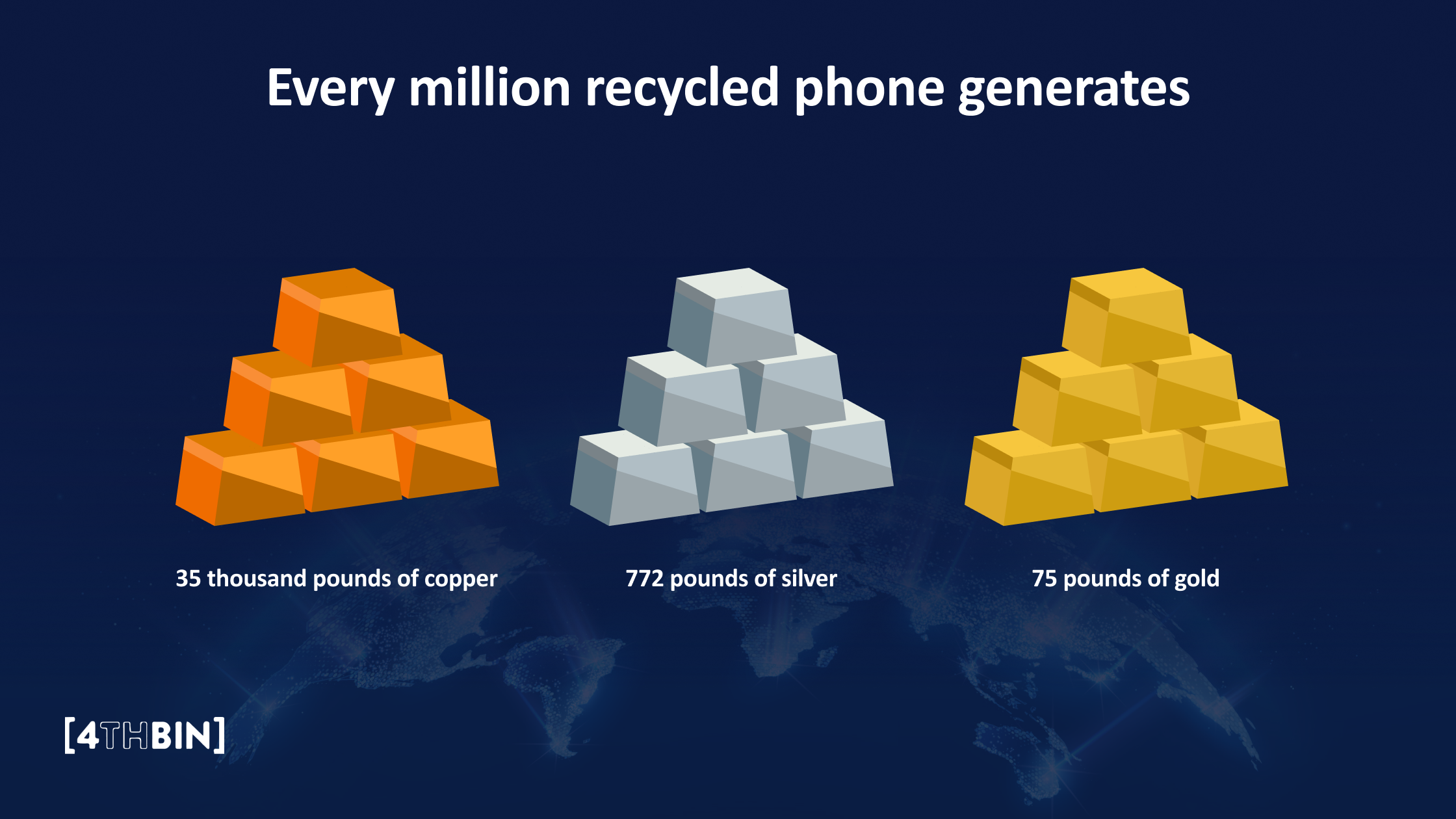
E-waste is also a massive economic opportunity that is largely being wasted. Discarded electronics contain an estimated $57 billion of recoverable materials annually, including gold, silver, copper, palladium, and rare earth metals.
In fact, 35 thousand pounds of copper, 772 pounds of silver, 75 pounds of gold, and 33 pounds of palladium can be recovered for every million recycled cell phones.
Yet, due to inefficient collection and recycling systems, most of these valuable resources are lost in landfills or incinerated instead of being recovered and reused.
To put this into perspective, one metric ton of circuit boards contains up to 100 times more gold than a metric ton of mined gold ore. This means that if e-waste were fully recycled, it could significantly reduce the need for environmentally destructive mining operations, which cause deforestation, water pollution, and habitat destruction.
However, because global e-waste recycling rates remain so low, most valuable materials are still wasted. Without stronger collection programs, corporate responsibility initiatives, and improved consumer awareness, we pollute the environment and throw away billions of dollars in recoverable resources annually.
6. Recycling Rates Vary Drastically by Country
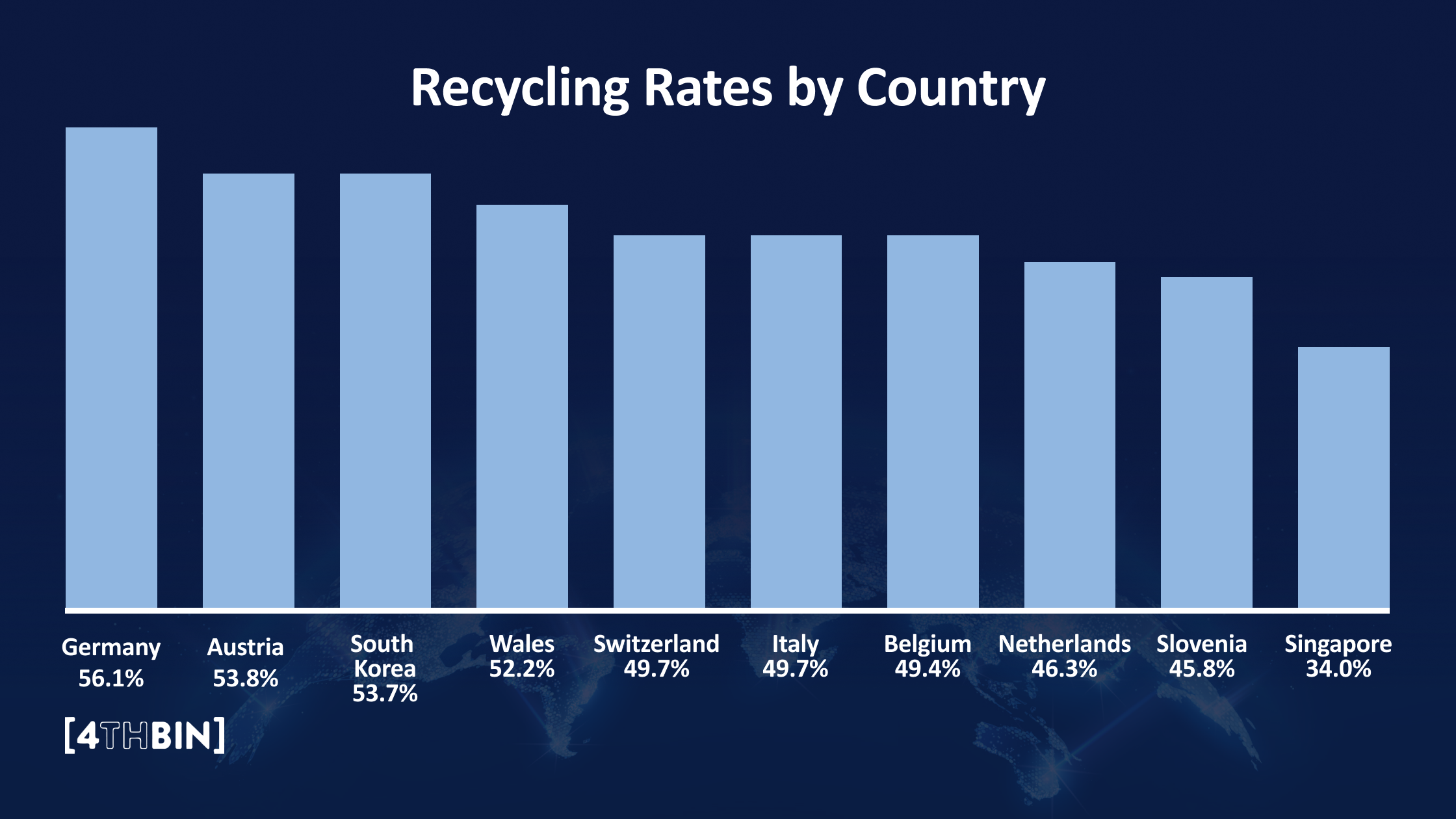
Recycling efforts differ dramatically from one country to another, revealing a global imbalance in waste management. Some nations have highly efficient recycling programs, while others struggle with limited infrastructure, weak regulations, or low public participation.
Germany is at the forefront, leading the world with a 56% recycling rate. Other countries, including South Korea, Austria, and the Netherlands, also boast recycling rates above 50%, showing that effective waste management is possible with the right policies.
In contrast, many countries — especially in developing regions of Africa, South America, and Asia—lack the necessary infrastructure to handle growing waste volumes. Even in wealthier nations, the disparity is striking.
The United States, for example, generates more waste per capita than almost any other country, yet its national recycling rate hovers around 35%—far behind other developed nations.
Additionally, the U.S. lacks federal-level recycling mandates, leaving waste management policies up to individual states, resulting in inconsistent programs and lower participation rates.
These stark differences in recycling rates highlight the need for stronger global regulations, better waste collection infrastructure, and increased public education.
7. The Global Circularity Rate is Declining
The concept of a circular economy—where materials are reused, repurposed, and recycled instead of discarded—has been promoted as the most effective way to reduce waste and minimize environmental damage. However, despite global efforts, the circularity rate is declining, meaning more raw materials are being extracted than reused. Over the past five years, the global circularity rate has dropped by 21%, indicating an increased reliance on virgin materials rather than recycled ones.
This decline is mainly due to inefficiencies in waste management, weak recycling infrastructure, and the rising complexity of consumer products. Many modern products—especially electronics—are designed to make them difficult to dismantle or recycle, with components glued, soldered, or mixed with non-recyclable materials. This makes it harder to extract and repurpose valuable materials into new products, leading to a higher demand for freshly mined resources.
8. Most Household Waste Still Ends Up in Landfills
Despite decades of awareness campaigns and government initiatives, most household waste still isn’t being correctly recycled. Only 19% of household and commercial waste is recovered through recycling or composting, while the rest is buried in landfills, incinerated, or illegally dumped. This includes plastics, packaging, food waste, and even electronics.
One of the most overlooked issues is how electronics are discarded along with regular household waste. Many consumers simply throw away their old phones, laptops, chargers, and other devices in the trash because they don’t know where to recycle them or e-waste collection programs aren’t easily accessible.
A major reason for this problem is confusion about recycling rules. Unlike paper, plastic, and glass, e-waste requires specialized recycling processes, yet many municipalities lack dedicated drop-off points or curbside collection programs.
In some regions, people are forced to pay fees to recycle electronics properly, discouraging participation. As a result, many devices end up in landfills or are shipped to countries with weak environmental regulations, where they are dismantled in unsafe, informal recycling operations.
9. The Biggest Contributors to the E-Waste Crisis
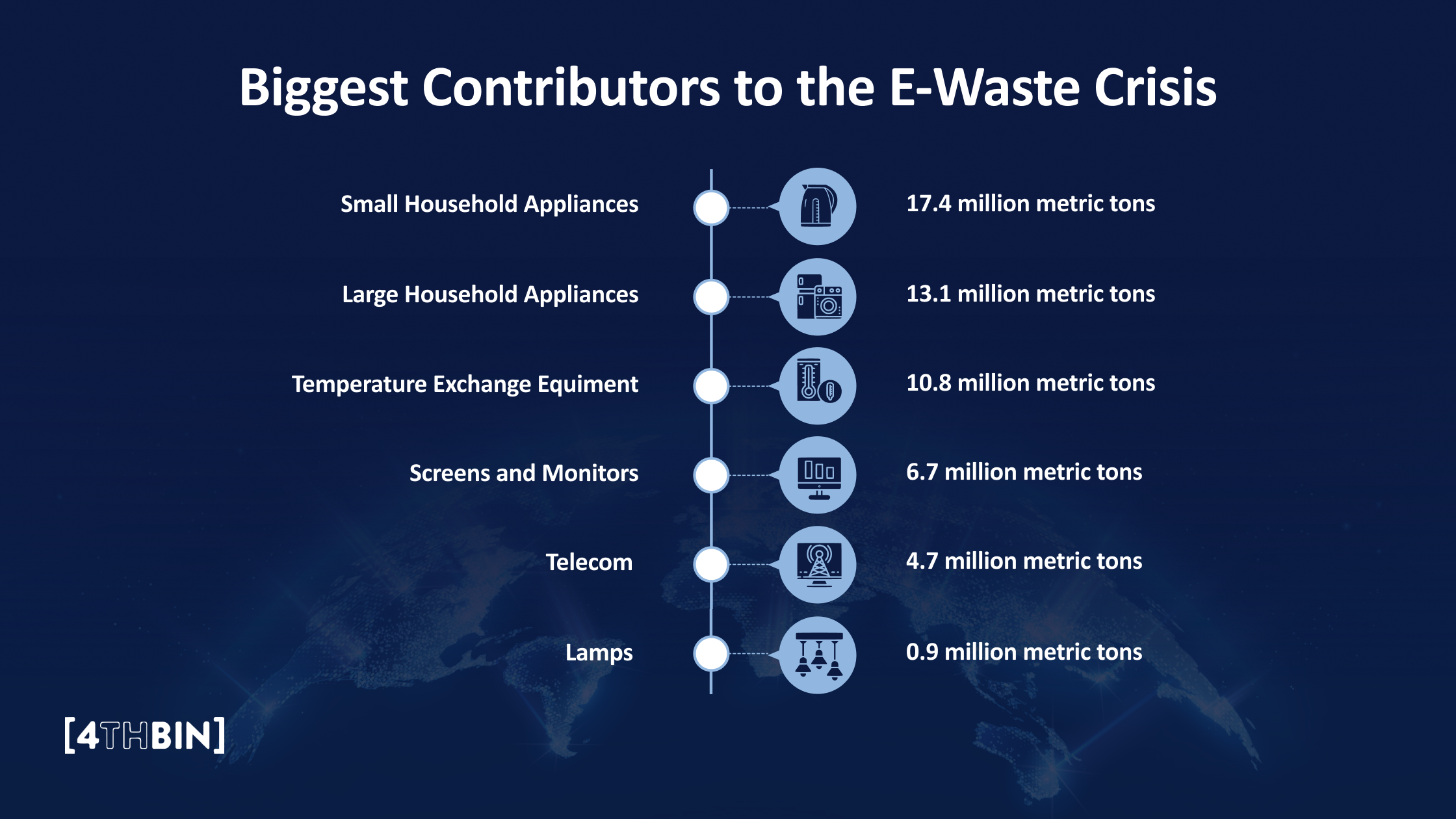
E-waste isn’t just discarded smartphones and computers, it includes a vast range of household and industrial electronics that are improperly disposed of every year. In 2025, e-waste generation is projected to exceed 60 million metric tons, and the breakdown of discarded electronics shows just how widespread the problem is:
- 17.4 million metric tons of small household appliances such as microwaves, vacuum cleaners, kettles, and power tools.
- 13.1 million metric tons of large appliances like washing machines, dishwashers, stoves, and dryers.
- 10.8 million metric tons of temperature exchange equipment, including refrigerators, freezers, air conditioners, and heat pumps.
- 6.7 million metric tons of screens and monitors, including televisions, computer monitors, laptops, and tablets.
- 4.7 million metric tons of small IT and telecom devices, such as mobile phones, routers, keyboards, and e-readers.
- 0.9 million metric tons of lamps, bulbs, and LEDs, which require specialized recycling due to their hazardous materials.
Source: E-Waste Monitor
Each item contains valuable materials like copper, gold, and aluminum, yet most are not recycled properly, leading to resource loss and environmental contamination. Without improved collection programs and better consumer awareness, millions of these devices will continue to be dumped in landfills or improperly dismantled in unsafe conditions.
10. E-Waste Legislation is Lacking Globally
Even though e-waste is a growing crisis, only 78 countries have any form of e-waste legislation. That leaves large parts of the world without proper systems to regulate collection, processing, and disposal.
As e-waste becomes a global crisis, more governments are introducing laws and regulations to address the problem. In 2023, 81 countries had e-waste legislation as opposed to 78 in 2019. However, out of these 81 countries, 67 had a legal instrument governing e-waste management with provisions promoting extended producer responsibility (EPR).
As of 2025, 25 U.S. states, including Arizona, Colorado, Florida, Georgia, Massachusetts, and Nevada, still have no e-waste recycling laws. This means that businesses or consumers in nearly half the country have no legal requirements to recycle electronics.
In countries without legislation, e-waste is often exported illegally to regions with weak environmental protections. This leads to hazardous “backyard recycling,” where people manually extract metals from electronics without protective equipment, exposing themselves to toxic fumes and chemicals. Moreover, electronics are often illegally dumped or burned, wasting billions of dollars in unrecovered valuable materials.
11. The Urgent Need for Better Recycling Infrastructure
Recycling is often promoted as a solution to the world’s waste problem. Still, without efficient and accessible infrastructure, it remains an underutilized and ineffective system in many parts of the world. General waste recycling and e-waste recycling suffer from gaps in collection, processing, and enforcement, making it challenging to keep valuable materials in circulation and prevent environmental harm.
Despite efforts to increase recycling rates, much of what could be recycled never reaches the proper facilities. Issues such as lack of curbside collection programs, contamination of recyclables, and inadequate sorting technology mean that millions of tons of plastic, paper, glass, and metal still end up in landfills or incinerators yearly.
The lack of proper infrastructure is even more pronounced for e-waste, which requires specialized processing due to its mix of valuable metals and hazardous components. Many countries do not have dedicated e-waste collection programs, forcing consumers to improperly hoard or dispose of old electronics. Even when e-waste is collected, many facilities lack the advanced technology to safely extract reusable materials, leading to inefficient recovery rates and increased reliance on raw material extraction.
For recycling to be genuinely effective, general waste and e-waste recycling need significant investment and reform. This includes:
- Expanding collection systems to ensure recyclables and electronics are properly disposed of.
- Investing in advanced recycling technology to improve material recovery rates.
- Stronger regulations and enforcement to hold manufacturers accountable for end-of-life product disposal.
- Public education campaigns to reduce contamination in recycling streams and increase participation.
Recycling is only as effective as the infrastructure that supports it. Without urgent improvements in waste management systems worldwide, general waste and e-waste will continue to overwhelm landfills, waste valuable resources, and contribute to environmental and health crises.
12. The Recycling Industry is a Lucrative Market
Recycling isn’t just good for the environment, it’s a thriving industry that generates billions of dollars and supports hundreds of thousands of jobs worldwide. If managed properly, recycling can be a significant economic driver, creating employment, reducing manufacturing costs, and fueling sustainable business growth.
- The U.S. recycling industry generates $170 billion annually, contributing significantly to the economy.
- Globally, shifting towards a greener economy, including expanded recycling efforts, could create 24 million new jobs by 2030.
- Proper e-waste recycling could unlock billions of dollars in recoverable materials, reducing reliance on costly raw material extraction.
- The recycling sector currently supports nearly 600,000 jobs in the U.S., spanning collection, processing, and manufacturing.
- Achieving a 75% national recycling rate could create 2.3 million new jobs by 2030.
These figures showcase how, for businesses and individuals, investing in better recycling infrastructure and policies isn’t just another ecological stance but a financial opportunity waiting to be seized.
4THBIN: Your Trusted Partner in Responsible E-Waste Recycling
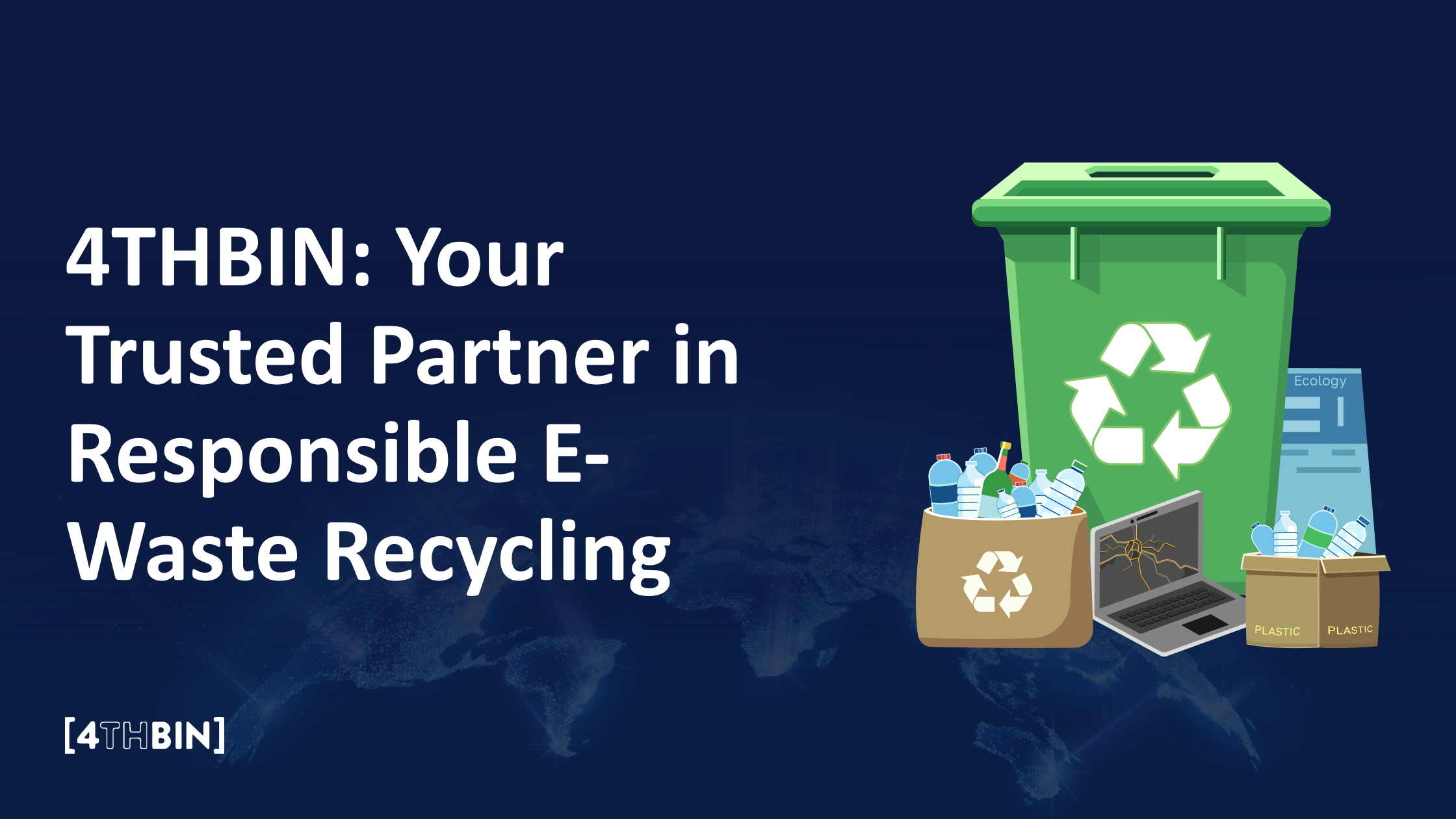
These recycling statistics show the urgent need for better waste management, especially regarding e-waste. Choose a certified and responsible solution instead of letting outdated electronics end up in landfills.
With 4THBIN ’s e-recycling solutions, organizations and individuals can rest assured of secure, compliant, and environmentally responsible electronic waste disposal.
With over a decade of experience, 4THBIN has partnered with more than 10,000 organizations, including Fortune 100 companies and small businesses, to transform e-waste challenges into opportunities. We make the process seamless, offering businesses a way to turn a potential liability into an opportunity for leadership in sustainability and responsibility.
Our certified data destruction services ensure that sensitive information is completely safeguarded, eliminating the risks of data recovery associated with improper disposal. From secure RemoteReturn mail-in options to convenient on-site collection, our customizable solutions allow you to choose the plan that best suits your organization’s needs.



